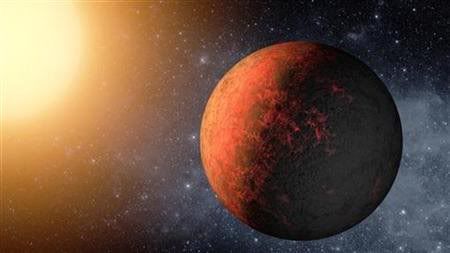Residents of Cowley County, Kansas caused a sensation last week when they captured video of the military towing a concealed object on a flatbed truck down US Highway 77. It wasn't long before a wave of speculation hit, claiming the object was a UFO.
Depending on the angle from which you spotted it, the 30 foot-wide mysterious craft appeared to be saucer-shaped. It was so large that local law enforcement had to remove roadside signage so it could pass through. But it was covered in a tightly concealed tarp, making any further examination impossible.
~ Dec.13, 2011
A closer look...
Thursday, December 22, 2011
Mexico Mayan region launches apocalypse countdown

MEXICO CITY (AP) — Seize the day.
Only 52 weeks and a day are left before Dec. 21, 2012, when some believe the Maya predicted the end of the world.
Unlike enthusiasts of other doomsday theories who suggest putting together survival kits, southeastern Mexico, the heart of Maya territory, plans a yearlong celebration.
Mexico's tourism agency expects to draw 52 million visitors by next year only to the regions of Chiapas, Yucatan, Quintana Roo, Tabasco and Campeche. All of Mexico usually lures about 22 million foreigners in a year.

It's selling the date, the Winter Solstice in the coming year, as a time of renewal. Many archeologists argue that the 2012 reference on a 1,300-year-old stone tablet only marks the end of a cycle in the Mayan calendar.
"The world will not end. It is an era," said Yeanet Zaldo, a tourism spokeswoman for the Caribbean state of Quintana Roo, home to Cancun. "For us, it is a message of hope."

Cities and towns in the Mayan region on Wednesday will start the yearlong countdown. In Chiapas the town of Tapachula on the Guatemalan border will start a countdown on an 8-foot digital clock in the main park exactly a year before the mysterious date.
In the nearby archaeological site of Izapa, Maya priests will burn incense, chant and offer prayers.
In the tropical jungle of Quintana Roo, between the resorts of Cancun and Playa del Carmen, people are putting messages and photos in a time capsule that will be buried for 50 years. Maya priests and Indian dancers will perform a ritual at the time capsule ceremony.

Yucatan state has announced plans to complete the Maya Museum of Merida by next summer.
"People who still live in Mayan villages will host rites and burn incense for us to go back in time and try to understand the Mayan wisdom," Zaldo said.
The Maya reputation for wisdom has people taking the alleged prediction seriously.
The Mayan civilization, which reached its height from 300 A.D. to 900 A.D., had a talent for astronomy
Its Long Count calendar begins in 3,114 B.C., marking time in roughly 394-year periods known as Baktuns. Thirteen was a significant, sacred number for the Mayas, and they wrote that the 13th Baktun ends on Dec. 21, 2012.
The doomsday theories stem from a stone tablet discovered in the 1960s at the archaeological site of Tortuguero in the Gulf of Mexico state of Tabasco that describes the return of a Mayan god at the end of a 13th period.
Believers have taken the end-of-the world fears to the Internet with hundreds of thousands of websites and blogs.
"The Maya are viewed by many westerners as exotic folks that were supposed to have had some special, secret knowledge," said Mayan scholar Sven Gronemeyer. "What happens is that our expectations and fears get projected on the Maya calendar."
Gronemeyer of La Trobe University in Australia compares the supposed Mayan prophecies to the "Y2K" hype, when people feared all computer systems would crash when the new millennium began on Jan. 1, 2000.
For some reason, Gronemeyer says, people have ignored evidence that dates beyond 2012 were recorded.
The blogosphere exploded with more speculation when Mexico's archaeology institute acknowledged on Nov. 24 a second reference to Dec. 21, 2012, on a brick found at other ruins.
"Human beings seem to be attracted by apocalyptic ideas and always assume the worst," Gronemeyer said.
It's all a bit frustrating for serious Mayan researchers whose field has made huge strides in recent years.
"This new historical and archaeological knowledge is so much more interesting and mind-blowing than the fantastical claims about Maya prophecies one sees on TV, books or on the Internet," David Stuart, a specialist in Mayan epigraphy at the University of Texas at Austin, said in an email to The Associated Press. "We're dealing with thousands of newly deciphered texts and trying to weave together a coherent picture of Maya history and culture, which to me is as exciting as it gets."
While the 2012 hype might increase interest in the Maya, "that will probably be offset by the long and difficult effort ahead to correct the ubiquitous lies and misconceptions, even after 2012 has come and gone," he wrote.
Jonnie Channell of Albuquerque, New Mexico, says that 2012 "is going to be one of those things where people are definitely going to have to plan," not because of impending apocalypse, but because hotel rooms in the Maya region are probably going to be full.
Channell, who owns Maya Sites Travel Services, is surprised that she already has 24 reservations for three tour packages she is offering to major Mayan ruin sites in the week leading up to the solstice.
She named one "Beginning the New Calendar Era Under the Yucatan Stars."
"We put together these tours, and we've got lots of signups, and people are excited about it," she said. "If anybody think it's going to be the end of the world, then they better stay home."

By ADRIANA GOMEZ LICON | AP – Wed, Dec 21, 2011
Associated Press writer Mark Stevenson contributed to this report
Wednesday, December 21, 2011
First Earth-sized planets found beyond solar system

~ An artist's rendering shows a planet called Kepler-20e in this handout released December 20, 2011.
Article By Irene Klotz
CAPE CANAVERAL, Florida (Reuters) - Astronomers have found a pair of Earth-sized planets orbiting a star similar to the sun, though neither are believed to be suitable for life, scientists on NASA's Kepler telescope team said on Tuesday.
The discovery follows confirmation earlier this month of a super-Earth sized planet, called Kepler-22b, that circles the right distance from its parent star for liquid water to exist on its surface. Water is believed to be a key ingredient for life.
"Kepler-22b has the right temperature, but it is too big. (The planets) we're announcing today are just the right size, but too hot," astronomer David Charbonneau with Harvard University, told reporters during a conference call.
"But you can bet that the hunt is on to find a planet that combines the best of both worlds, a true Earth twin," he said.
The newly discovered planets, called Kepler-20e and 20f, have at least three gas-giant siblings, one of the larger planetary systems found to date.
But the family is nothing like our solar system, where rocky worlds like Venus, Earth and Mars are grouped together closer in toward the sun while gas giants like Jupiter and Saturn are segregated in the outer regions.
The two Earth-like and three Neptune-sized planets in the Kepler-20 family are interspersed and all orbit closer to the parent star than our solar system's innermost planet, Mercury.
"Rocky planets and gas giants happily mingle together. This is the first time we've seen anything like this," Charbonneau said.
Kepler-20e and 20f, which are believed to be too hot for liquid water, probably are not habitable - at least not today.
"If Kepler-20f was formed with water, which I think is likely, then it could have held on to its water for several billions of years ," said astronomer Linda Elkins-Tanton with the Carnegie Institute in Washington D.C.
"And that means that this planet could have been habitable in the past for a long period," she said.
The system is located about 1,000 light-years away in the constellation Lyra.
Light travels at about 299,337 km per second.
(Editing by Kevin Gray and Sandra Maler)
Subscribe to:
Comments (Atom)


















